Hacienda tokens from Sinaloa (later)
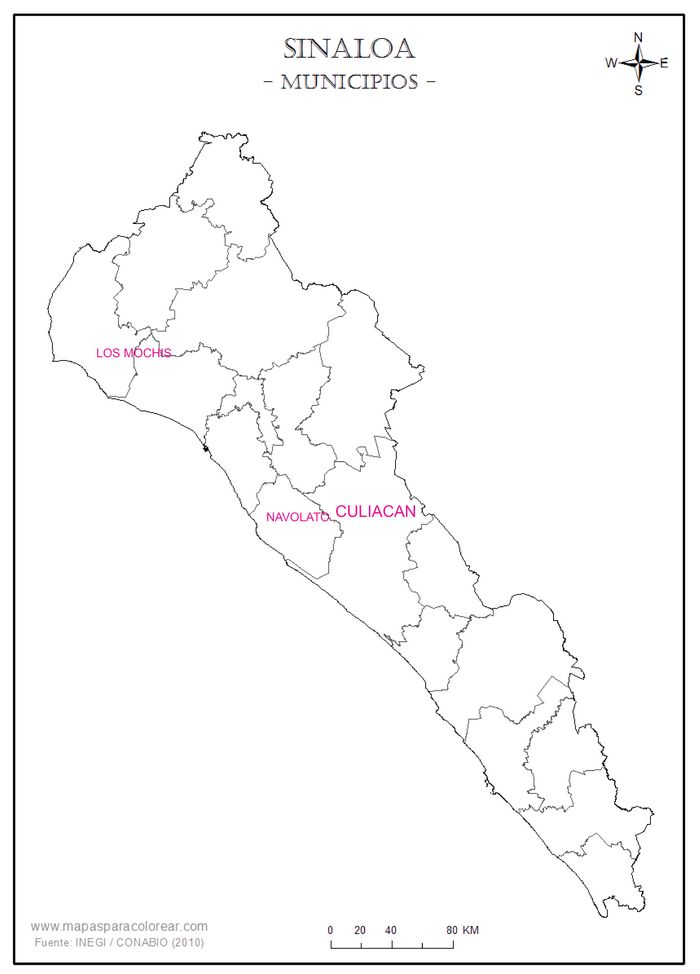 Navolato
Navolato
Hacienda la Primavera

West view of the sugar mill at Hacienda "La Primeravera"
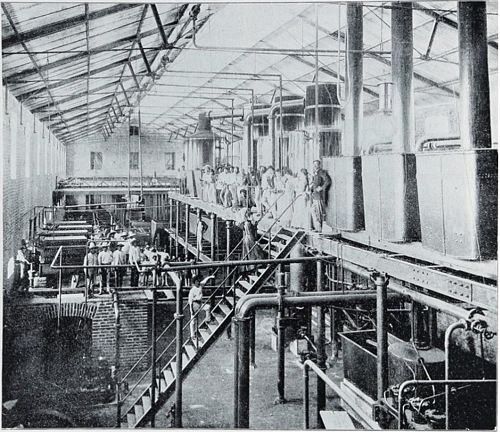
Tanks for honey, triple effect and carbonation, second floor of the mill
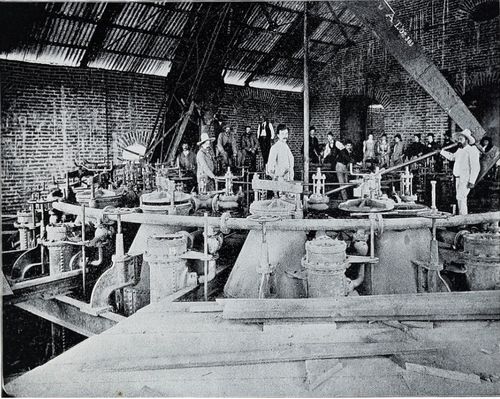
The rich and politically influential brothers, Jesús and Jorge Almada de la Vega, established the hacienda La Primavera in 1880 to grow sugarcane, vegetables, bananas and other fruit.
On 11 February 1893 they opened the sugar mill (ingenio azucarero) that came to dominate Navolato. With 400 hectares of cane the Almadas needed workers and offered the possibility of earning 5 to 8 reales per day, and the labourers would have a house and land without paying rent, or a plot and wood to build their own house; and even a cow to be paid for over time.
The great sugar factory and distillery “La Primavera” is situated in the town of Navolato, in the district of Culiacan, on the Occidental R. R. It is 31 kilometres distant from Culiacan, the capital of the State of Sinaloa, and an equal distance from the port of Altata. Navolato has two main features for making a splendid manufacturing site—water and easily cultivated land. Its land extension comprises 35,000 acres, with sufficient water to thoroughly irrigate over 50,000 acres, such irrigation being by means of a canal, capable of furnishing 14 cubic metres of water. Two centrifugal pumps are used which supply 8,000 gallons of water each minute. On part of this land, cane sugar is principally cultivated, but cotton, corn, beans and wheat could be raised equally as well. The sugar-cane only requires two irrigations each season, and cereals only one. The cane produces to each acre 40 tons of sugar at an actual cost of one Mexican dollar per acre for one year. The actual acreage under sugar-cane cultivation is 1,700, the yield in sugar averaging 40 tons to the acre. Over 9,000 meters of wire fencing attached to extra stout poles has been completed, and altogether the sugar plantation is in splendid condition, nothing being neglected or overlooked. The plantation is crossed by the Occidental R. R. track, the station Navolato being the busiest on the road. This fact greatly facilitates shipping operations, as products of the sugar factory or distillery can be delivered in Culiacan or Altata within two hours from time of shipment. Near the track is the sugar factory, 200 yards square, an immense brick and stone building with iron supports, completely fitted up and equipped with the latest improved and most modern machinery, capable of manufacturing 300 tons of sugar every 24 hours. Close by is the alcohol distillery and the liquor distillery, the first one of its class in the Republic of Mexico. From 28 to 30 different kinds of liquors and liqueurs, etc., are manufactured, which for purity and good flavor cannot be excelled. A large store room, 50 x100, is stocked with cases containing Cognac, Port, Sherry, Angelica, Vermouth, Chatreuse, Damiana Bitters, Cordials, etc., the entire product finding a ready market throughout Sonora, Lower California, Sinaloa and all Pacific Coast points. A complete inventory of all “ La Primavera” contains would take more space than is at our disposal. Suffice it to say that over 900 persons are employed, 400 mules and 60 wagons. There is a tramway line extending all over the plantation, with an equipment of 100 flat cars for conveying the cane to the mills. These mills have a capacity of 600 tons daily, the crushed cane being used for fuel. There are twelve boilers of 1,000 horse-power; a machine and blacksmith shops; box factory and planing mill; two alcohol distilleries; complete electric light plants for lighting the factory and the town of Navolato; cube sugar machine, 20,000 pounds a day capacity; new distillery brick and iron building three stories high, and 300 houses for employees, etc. The town of Navolato is laid out perfectly, and would attract attention anywhere. A beautiful avenue over a mile long and 100 feet wide, flanked by gorgeous palms and banana trees, divides it, and the blocks are 100 yards square. Five years ago these blocks could have been purchased for $10 each; they are now worth $700. This will give the outsider an idea of progress and enterprise in Navolato. There is also a fine fruit orchard, con taining two thousand orange, 30,000 banana and 200 fig trees, all bearing fruit, besides various other fruit trees, such as mangoes, guavas, pineapples, plums, alligator pears and other semi-tropical fruits.
Topographically speaking, Navolato occupies a better position for the production of sugar than Honolulu, Hawaiian Islands, or Cuba, and can sell to the United States cheaper than any sugar-producing country known, not only by reason of cheap production, but from the fact of the freight rate to San Francisco from Navolato being only $3.00 per ton, and also taking into consideration that the expense is in silver and the sales in gold. Navolato, with all its lands under cultivation, can produce from forty to fifty thousand tons of sugar each season at an insignificant cost in silver, and can export its product and sell for gold. The lands are all cleared and fenced, and with everything in running order an enormous profit can be made at a very slight outlay.
If all the available lands were under cultivation, it would undoubtedly result in giving the death-blow to the sugar trust of the United States, since the expense, relatively speaking, is almost nothing for sugar cultivation. At present the entire products of the factory are easily sold throughout Sonora, Sinaloa, Lower California, Durango, Chihuahua and Pacific Coast points, the profit on these sales alone being more than sufficient for running a plant capable of manufacturing from forty to fifty thousand tons of sugar annually. The proprietors, Messrs. Jesus & Jorge Almada, have invested in their gigantic enterprise a capital of over two million dollars. They have spared no expense in making improvements, having spent large sums of money on irrigation work and other projects, which have resulted in making their property the most advanced of its kind in the State of Sinaloa, Five years ago Navolato was the center of a wilderness. To-day, through their unremitting energy and enterprise, it has a population of over 2,000 people, and the surrounding land is in a state of high productiveness. The following will give the reader an idea of the foresight and enterprise of Messrs. Jesus & Jorge Almada. In 1896, when corn was worth fifty cents a bushel throughout Mexico, “La Primavera ” was in need of laborers. To attract them, the proprietors of the factory advertised far and near that they would sell corn at twenty-five cents per bushel. Within ten days they had all the laborers they needed. It is to such men as Messrs. Jesus & Jorge Almada that modern Mexico owes her present prosperity and looks for her future greatness.
Whatever pertains to the advancement of Sinaloa’s interests finds ready and generous support from Messrs. Jesus & Jorge AlmadaEl Estado de Sinaloa, Mexico, Sus Industrias Comerciales, Mineras y Manufacturas, J. R. Southworth, San Francisco, November 1898.
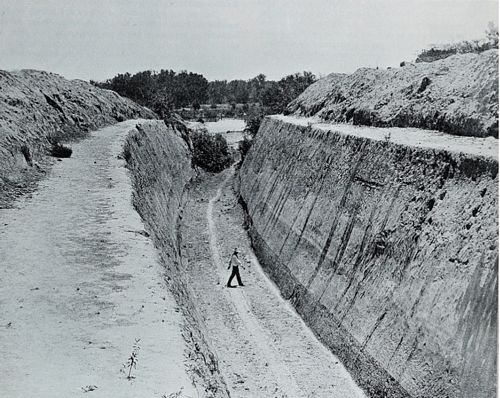
These company tokens are for a certain period (sixteenth, eighth, quarter, half(?) or a day) of work.
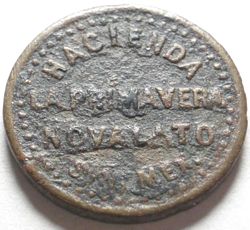

Grove 1538
Obverse: HACIENDA / LA PRIMAVERA / NOVALATO / SIN, MEX.
Reverse: BUENO POR / UN / DIEZ Y SEISAVO / DIA / DE TRABAJO
17mm. bronze
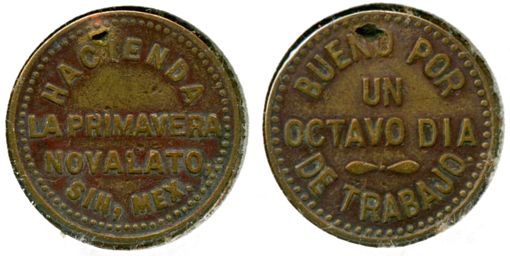
Grove 1539
Obverse: HACIENDA / LA PRIMAVERA / NOVALATO / SIN, MEX.
Reverse: BUENO POR / UN / OCTAVO DIA / DE TRABAJO
20mm. bronze

Obverse: HACIENDA / LA PRIMAVERA / NOVALATO / SIN, MEX.
Reverse: BUENO POR / UN / CUARTO DIA / DE TRABAJO / J. ALMADA Y HNO
mm. bronze

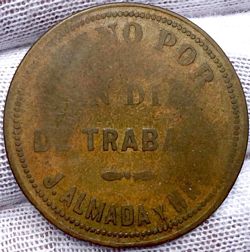
Grove 1540
Obverse: HACIENDA / LA PRIMAVERA / NOVALATO / SIN, MEX.
Reverse: BUENO POR / UN DIA / DE TRABAJO / J. ALMADA Y HNO
17mm. bronze
Los Mochis
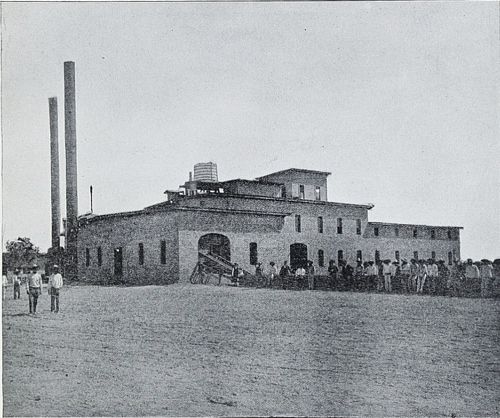
El Aguila sugar mill, Villa de Ahome
Benjamin Francis Johnston was born in New York on 15 December 1865. In 1890, he arrived in northern Sinaloa attracted by the city project of engineer Albert Kimsey Owen, and saw the opportunity to exploit resources such as sugar cane. He teamed up with Zacarías Ochoa, owner of a trapiche, (rudimentary sugar mill) called "El Águila", in Villa de Ahome. The two founded a new partnership, El Águila Sugar & Refining Company.
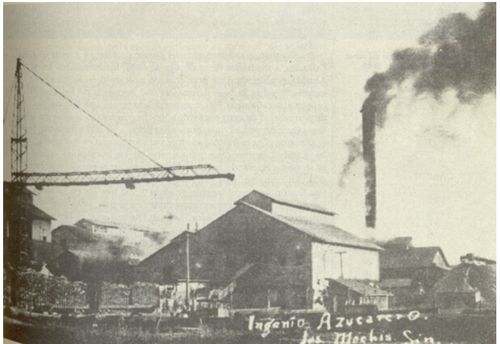
In 1894 he founded The Sinaloa Sugar Company, with a capital of $ 500,000 US dollars. In 1898 he laid the foundation stone of what would be one of the most important sugar factories in the northwest of the republic. In 1901, he built on his own the sugar mill in Los Mochis, acquiring a property of more than 16,000 hectares, and obtaining from the federal government the concession of a part of the use of water from the Río Fuerte. The adjacent village was to grow into the town of Los Mochis.
In 1916, Johnston merged the "El Águila" sugarmill and the "La Victoria" distillery and formed the United Sugar Companies.
These company tokens are all proofs (comprobantes) for a certain period (hour, day) of work.
Compañía Azucarera del Aguila
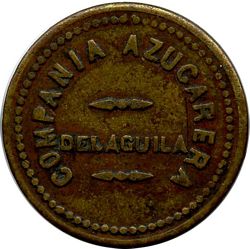
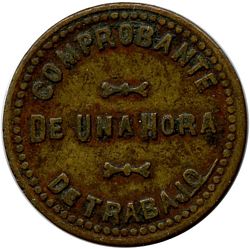
Obverse: COMPANIA AZUCARERA / DEL AGUILA
Reverse: COMPROBANTE / DE UNA HORA/ DE TRABAJO
21mm. brass
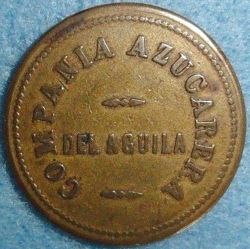
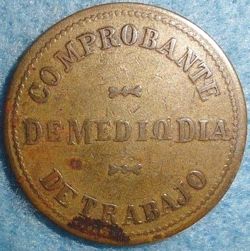
Obverse: COMPANIA AZUCARERA / DEL AGUILA
Reverse: COMPROBANTE / DE MEDIO DIA / DE TRABAJO
brass

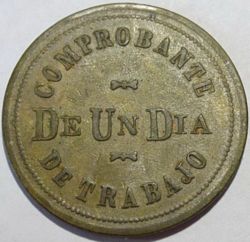
Grove 1297
Obverse: COMPANIA AZUCARERA / DEL AGUILA
Reverse: COMPROBANTE / DE UN DIA / DE TRABAJO
38mm. brass
Sinaloa Sugar Company
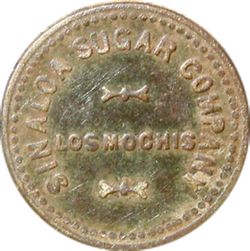
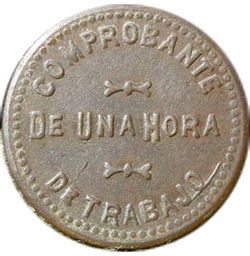
Obverse: SINALOA SUGAR COMPANY / LOS MOCHIS
Reverse: COMPROBANTE / DE UNA HORA/ DE TRABAJO
Grove 1909
Obverse: SINALOA SUGAR COMPANY / LOS MOCHIS
Reverse: COMPROBANTE / DE MEDIO DIA/ DE TRABAJO
31mm.
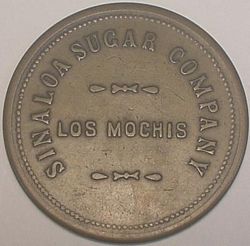
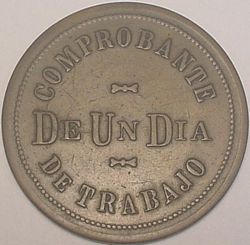
Obverse: SINALOA SUGAR COMPANY / LOS MOCHIS
Reverse: COMPROBANTE / DE UN DIA/ DE TRABAJO
In early 1903 a Sinaloan sugar company was reported to the Secretaría de Hacienda for paying its workers with fichas and vales, in contravention to the law. The Secretaría investigated and, finding the charges proved, imposed a sizeable fine and told the company to destroy the fichas and vales. A newspaper stated that as the company was powerful and exerted a lot of pressure to put an end to the matter, the government’s action made a good impressionEl Tiempo, Año XX, Núm. 5873, 9 May 1903. This is no doubt a reference to the Sinaloa Sugar Company.
United Sugar Companies
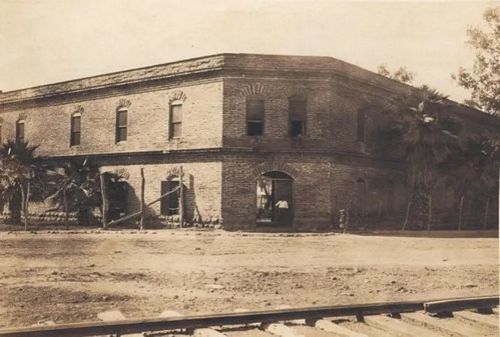
The offices of the United Sugar Companies, Los Mochis
In the first decade of the twentieth century this organisation was called the United Sugar Companies and dominated the economy of the region. It operated in a typically capitalist fashion and ironically was ultimately supported by Carranza and the local government against its own workers, who had been champions of the revolution.
Before the revolution the companies’ operations in Sinaloa had been in such financial difficulties that from 1907 to 1911 the Banco Nacional de México, one of its major creditors, had sent a representative, Joaquín Olloqui, to Los Mochis to oversee its finances and authorise every cheque. After Olloqui left, the companies had greater liberty and issued its own paper money of $2, $5 and $10 or vales al portador for larger amounts. With these it paid its wages, covered its debt and even brought propertiesFiliberto Leandro Quintero, Historia Integral de la región de la región del Río Fuerte, Los Mochis, Ed. El Debate, 1978, p. 547.
In 1908 Johnston had been appointed United States vice-consul. The U. S. shield over his offices protected his properties during the revolution and and apparently Johnston used the diplomatic bag to smuggle in counterfeit money. The company was said to have used depreciated paper money (bilimbiques) from other states to pay its creditorsMario Gill, La conquista del Valle del Fuerte, Culiacán, UAS – IICH, 1983, p. 69 and to buy garbanzos at extremely low prices, which it then sold in the United States for dollarsMario Gill, op. cit., p. 71.
In 1915 it again used comprobantes.
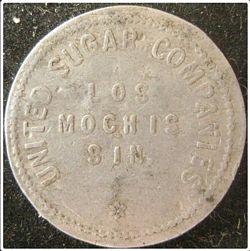
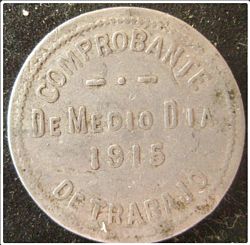
Obverse: SINALOA SUGAR COMPANY / LOS / MOCHIS / SIN.
Reverse: COMPROBANTE / DE MEDIO DIA/ 1915 / DE TRABAJO
Islas Marías
Hacienda Tres Marías
The Islas Marías make up an archipelago consisting of four islands. They are located in the Pacific Ocean, some 100 kilometres (62 miles) off the coast of the state of Nayarit and about 370 kilometres (230 miles) southeast of the tip of Baja California
The islands were granted to General José López Uraga on 5 May 1862 as a reward for his services to the nation. He later lost possession of them because he had served Maximilian and the Liberal Government confiscated them but, due to an amnesty law dictated by Benito Juárez, he had them returned on 14 October 1870. Fearing further political reprisals, he sold them as quickly as possible, in 1878, to Manuel Carpena, a merchant from San Blas and Tepic, who paid $45,000 pesos for them. Manuel and his relatives began various commercial activities, organizing production of the salt pans (salinas) that existed there, bringing in cattle and goats, and marketing the rich woods that abounded there.
When Manuel Carpena died, his wife, Doña Gila Azcona Izquierdo, became the executor of his will but, as she was unable to attend to the business related to these islands, she decided to sell them to the Federal Government, and the respective contract was signed on 31 January 31, 1905, for the amount of $150,000 pesos. On 12 May Porfirio Díaz, signed a decree that would destine the islands as a place for the establishment of a new penal colony.
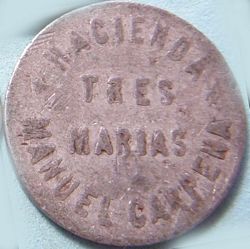
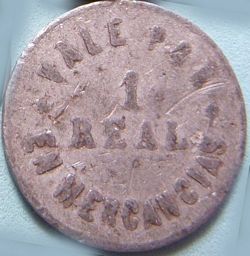
Obverse: HACIENDA / TRES MARIAS / MANUEL GANDERA
Reverse: VALE POR / 1 / REAL / EN MERCANCIAS
23mm. aluminum
Grove 1635
Obverse: HACIENDA / TRES MARIAS / MANUEL GANDERA
Reverse: VALE POR / 2 / REALS / EN MERCANCIAS
25mm.
.
